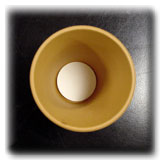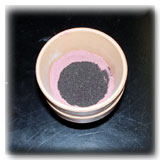 |
 |
Introduction
Another great example of a thermodynamically spontaneous reaction is the thermite reaction. Here, iron oxide (Fe2O3 = rust) and aluminum metal powder undergo a redox (reduction-oxidation) reaction to form iron metal and aluminum oxide (Al2O3 = alumina):
Fe2O3(s) + 2 Al(s) ![]() Al2O3(s) + 2 Fe(l)
Al2O3(s) + 2 Fe(l)
This reaction is so exothermic that the iron is actually molten! In fact, thermite has been used for underwater welding. Years ago, students at MIT used thermite to weld trolleys to their tracks as a "prank" (Note: nowadays you would face severe criminal penalties, so don't even think it).
![]()
Potassium permanganate. KMnO4, is a potent oxidizing agent. Upon contact with organic materials such as acetone, glycerin etc., a violent reaction takes place that consumes the organic material and leaves behind a residue of Mn2O3. This makes an interesting pyrotechnic demonstration of chemical incompatibility in its own right, but is not our present focus:
14 KMnO4(s) + 4 C3H5(OH)3(l) ![]() 7 K2CO3(s) + 7 Mn2O3(s) + 5 CO2(g) + 16 H2O
7 K2CO3(s) + 7 Mn2O3(s) + 5 CO2(g) + 16 H2O
 |
The thermite reaction is an exceedingly dangerous reaction and should only be performed by a trained chemical professional capable of assessing the hazards and risks. Do not run this reaction indoors unless it is done in a fume hood with the sash closed. Keep all personnel back at least 30 feet (10m) and delineate this safety zone with a barrier, caution tape etc. Regardless of whether this reaction is run in a hood or outdoors, one should use a blast shield of sufficient height to contain ejecta. The demonstrator should use appropriate PPE such as a face shield, fire-resistant gloves, laboratory coat, long pants, and closed-toe shoes, and PPE such as impact-resistant safety goggles should be considered for audience members. A fire extinguisher should be immediately available in case secondary fires are ignited. Injuries have occurred during attempts to run this reaction; use at your own risk. For example, see http://chronicle.augusta.com/latest-news/2010-06-02/tech-student-appling-burned?v=1275461805. |  |
This reaction is classically run in a small clay flower pot suspended from a ring stand - the hole in the bottom of the pot permits the molten iron to drip down to the delight of the audience. In our experience, the pot generally cracks or shatters from the extreme temperatures during the demonstration (> 1,500 °C) and ruins this effect. The solution is to use two stacked flower pots. The inner one will usually crack, but the second one will stay intact.
| In this particular example we used 50 g of finely powdered Fe2O3, 15 g of aluminum powder, 20 g of KMnO4 and a few mL of glycerin. It is up to the chemistry student to determine the molar ratios. We also needed two clay flower pots, a piece of filter paper, a test tube to tamp the powders, a metal ring stand, metal ring, and metal bucket filled with dry sand. |  |
The two clay pots were stacked and a small filter paper was placed in the bottom of the topmost pot. This prevents the powder from falling out the bottom - and it will burn away during the experiment to allow the molten iron to flow. The aluminum powder and Fe2O3 were then placed in the pot:


In the above right picture, you can see the red Fe2O3 and metallic Al which have not yet been mixed (some chemists like to mix the powders before putting them in the flowerpot). In this case, we simply gave the powders a good stir to produce a homogeneous mixture. After stirring, the next step was to pack the powder mixture down with a large test tube, creating a crater-shaped indentation in the process. The postassium permanganate was then poured into the depression (do not mix the permangante with the other chemicals!). Finally, another cone-shaped depression was made in the postassium permanganate to create a confined area into which the glycerin can be poured to initiate the chemical reactions. (Do NOT add the glycerin now - or BOOM!)



Finally, the flowerpot was placed on a metal ring stand and a metal bucket full of DRY sand was placed beneath it to catch the molten iron. The whole apparatus was assembled in a fume hood dedicated to this particular demonstration (note the scarring of the hood surfaces - that back wall is actually a window) Remove ALL other materials, especially anything combustible, flammable, or breakable from the hood:

 |
NEVER UNDER **ANY** CIRCUMSTANCES USE WATER IN PLACE OF THE DRY SAND! Years ago, some chemists allowed the molten iron to drop into water because this creates additional smoke and steam. However, this process also sets up conditions under which the molten iron may explode with tremendous force. On at least one occasion, this practice has showered the audience with molten iron, causing injuries. NEVER UNDER **ANY** CIRCUMSTANCES USE WATER IN PLACE OF DRY SAND! |
 |
After an appropriate warning to the audience about the brilliant light that would be produced, the reaction was initiated by quickly but carefully pouring the glycerin into the permanganate crater. The hood sash was then quickly closed (in the video below, the sash is left open for better video quality; no audience was present).
|
Click on the image at the right to view a QuickTime movie of the demonstration (you can download this for your platform if it is not already installed on your computer). The file is 724 Kb. The actual duration of the demo is longer than shown because the initiation period of the permanganate (edited out) usually takes 20 - 60 seconds. If you look closely at the movie, you can actually see the molten iron dripping into the bucket as well as the light emitted by the molten iron in the bucket. This is especially impressive in a darkened room. And at the very end, if you listen closely, you can hear the inner flower pot crack. At the end of the move we picked up the molten blob of iron with tongs. It is always impressive for an audience (from a distance). Remember, NEVER put molten blobs like this into water - see the warning(s) above!! |
![]()
Let's calculate how much thermal energy is released in this reaction. If we look at the standard state enthalpy values for the products and reactants we find they are:
| Component | |
|---|---|
| Fe2O3(s) | -822.2 |
| Al(s) | 0 |
| Al2O3(s) | -1,669.8 |
| Fe (s) | 0 |
Fe and Al are zero because, by definition, the ![]() Hfo of elements in their standard states is zero (OK, technically the iron is in the liquid state, but in the end it becomes solid again).
Hfo of elements in their standard states is zero (OK, technically the iron is in the liquid state, but in the end it becomes solid again).
Fe2O3(s) + 2 Al(s) ![]() Al2O3(s) + 2 Fe(l)
Al2O3(s) + 2 Fe(l)
The ![]() H for this reaction is the sum of the
H for this reaction is the sum of the ![]() Hfo's of the products - the sum of the
Hfo's of the products - the sum of the ![]() Hfo's of the reactants (multiplying each by their stoichiometric coefficient in the balanced reaction equation), i.e.:
Hfo's of the reactants (multiplying each by their stoichiometric coefficient in the balanced reaction equation), i.e.:
![]() Horxn = (1 mol)(
Horxn = (1 mol)(![]() HfoAl2O3) + (2 mol)(
HfoAl2O3) + (2 mol)(![]() HfoFe) - (1 mol)(
HfoFe) - (1 mol)(![]() HfoFe2O3) - (2 mol)(
HfoFe2O3) - (2 mol)(![]() HfoAl)
HfoAl)
![]() Horxn = (1 mol)(-1,669.8 kJ/mol) + (2 mol)(0) - (1 mol)(-822.2 kJ/mol) - (2mol)(0 kJ/mol)
Horxn = (1 mol)(-1,669.8 kJ/mol) + (2 mol)(0) - (1 mol)(-822.2 kJ/mol) - (2mol)(0 kJ/mol)
![]() Horxn = -847.6 kJ
Horxn = -847.6 kJ
That is a fairly large energy change. For comparison, the combustion of methane gas is -818 kJ/mol and in the carbon dioxide/Mg demo the energy released was -810.1 kJ.
The thermodynamic driving force for this reaction is the high stability (low free energy) of the Al2O3. We could also say that Al3+ has a greater affinity for oxygen than Fe3+ does, a property we call oxophilicity (literally, "oxygen loving").
![]()
[Top of Page] [Demo Lab Home Page]
This page was last updated Friday, March 27, 2015 and is copyright 2002 - 2025 by Rob Toreki. All rights reserved. Thanks to the late Terry Todd for his assistance in preparing the demonstration and his on-screen cameo appearance. You are missed, friend.